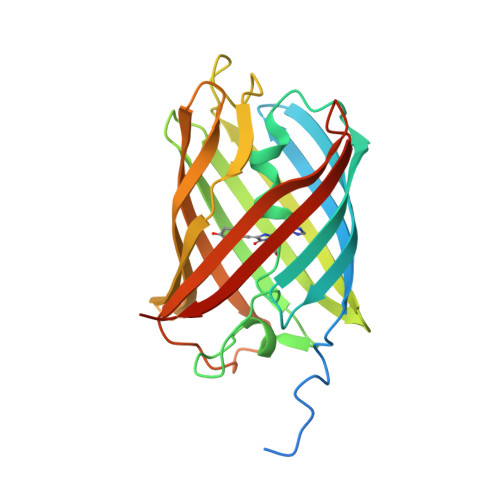Mechanistic Investigations of Green mEos4b Reveal a Dynamic Long-Lived Dark State.
De Zitter, E., Ridard, J., Thedie, D., Adam, V., Levy, B., Byrdin, M., Gotthard, G., Van Meervelt, L., Dedecker, P., Demachy, I., Bourgeois, D.(2020) J Am Chem Soc
- PubMed: 32463688
- DOI: https://doi.org/10.1021/jacs.0c01880
- Primary Citation of Related Structures:
6GOZ - PubMed Abstract:
Green-to-red photoconvertible fluorescent proteins (PCFPs) are key players in advanced microscopy schemes such as photoactivated localization microscopy (PALM). Whereas photoconversion and red-state blinking in PCFPs have been studied intensively, their green-state photophysical behavior has received less attention. Yet dark states in green PCFPs can become strongly populated in PALM schemes and exert an indirect but considerable influence on the quality of data recorded in the red channel. Furthermore, green-state photoswitching in PCFPs can be used directly for PALM and has been engineered to design highly efficient reversibly switchable fluorescent proteins (RSFPs) amenable to various nanoscopy schemes. Here, we demonstrate that green mEos4b efficiently switches to a long-lived dark state through cis - trans isomerization of its chromophore, as do most RSFPs. However, by combining kinetic crystallography, molecular dynamics simulations, and Raman spectroscopy, we find that the dark state in green mEos4b is much more dynamic than that seen in switched-off green IrisFP, a biphotochromic PCFP engineered from the common EosFP parent. Our data suggest that H-bonding patterns maintained by the chromophore in green PCFPs and RSFPs in both their on- and off-states collectively control photoswitching quantum yields. The reduced number of H-bonds maintained by the dynamic dark chromophore in green mEos4b thus largely accounts for the observed lower switching contrast as compared to that of IrisFP. We also compare the long-lived dark states reached from green and red mEos4b, on the basis of their X-ray structures and Raman signatures. Altogether, these data provide a unifying picture of the complex photophysics of PCFPs and RSFPs.
Organizational Affiliation:
Department of Chemistry, KU Leuven, Heverlee 3001, Belgium.


















